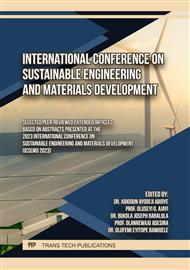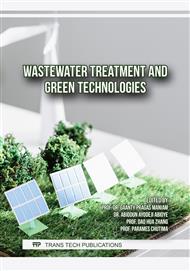[1]
Y. Cao, J. Yang, M. Xian, X. Xu, W Liu. Increasing unsaturated fatty acid contents in Escherichia coli by coexpression of three different genes. Appl Microbiol Biotechnology. 87 (2014) 271–280.
DOI: 10.1007/s00253-009-2377-x
Google Scholar
[2]
I.A. Musa. The effects of alcohol to oil molar ratios and the type of alcohol on biodiesel production using transesterification process. Egyptian Journal of Petroleum, 25(1) (2016) 21-31.
DOI: 10.1016/j.ejpe.2015.06.007
Google Scholar
[3]
C.J.H. Hartnady. South Africa's diminishing coal reserves. South African Journal of Science 106 (9) (2010): 1-5.
DOI: 10.4102/sajs.v106i9/10.369
Google Scholar
[4]
E.C. Linganiso, B. Tlhaole, L.P. Magagula, S. Dziike, L.Z. Linganiso, T.E. Motaung, N. Moloto, Z.N. Tetana. Biodiesel Production from Waste Oils: A South African Outlook. Sustainability 14 (4) (2022) 1983.
DOI: 10.3390/su14041983
Google Scholar
[5]
Biofuels Industrial Strategy (BIS) of the Republic of South Africa. Department of Minerals and Energy, http:// www.info.gov.za/view/DownloadFileAction?id=77830 (accessed June 2 2022).
Google Scholar
[6]
C. Mbohwa, A. Mudiwakure, (2013), The status of Used Vegetable Oil (UVO) Biodiesel production in South Africa, Proceedings of the World Congress on Engineering. 1 (2013) 1-3
Google Scholar
[7]
G. BoroumandJazi, B. Rismanchi, and R. Saidur. Technical characteristic analysis of wind energy conversion systems for sustainable development." Energy conversion and management 69 (2013) 87-94.
DOI: 10.1016/j.enconman.2013.01.030
Google Scholar
[8]
P. Prisecaru. Challenges of the fourth industrial revolution. Knowledge Horizons. Economics. 8(1) (2016) 57.
Google Scholar
[9]
N.H. Che Hamzah, N.Khairuddin, B.M. Siddique, M.A. Hassan. Potential of Jatropha curcas L. as biodiesel feedstock in Malaysia: A concise review. Processes, 8(7) (2020) 786.
DOI: 10.3390/pr8070786
Google Scholar
[10]
G. Knothe. Dependence of biodiesel fuel properties on the structure of fatty acid alkyl esters., Fuel Process Technology. 86, (2010) 1059–1070.
DOI: 10.1016/j.fuproc.2004.11.002
Google Scholar
[11]
A.A. Eras-Almeida, M.A. Egido-Aguilera. What is still necessary for supporting the SDG7 in the most vulnerable contexts?. Sustainability. 12(17) (2020) 7184.
DOI: 10.3390/su12177184
Google Scholar
[12]
T. G. Balachandran, S. Sendilvelan, K. Bhaskar, (2017), A Comparative Evaluation of Usage of Methyl Esters of Jatropha and Fish Oil for Environmental Protection, Journal of Materials and Environmental Sciences. 8(7) (2017) 2564-2571.
DOI: 10.1007/978-3-319-73645-7_142
Google Scholar
[13]
W. Bandason, C. Parwada, J. Musara, G. Nyamushamba, T. Kaseke (2021). Unlocking the potential of value chains as climate change resilience strategies: can macadamia nuts (macadamia integrifolia) offer the gateway?. South African Journal of Agricultural Extension (SAJAE). 49 (3) (2021), 62-75
DOI: 10.17159/2413-3221/2021/v49n3a12852
Google Scholar
[14]
T. Kaseke, O.A. Fawole, U.L. Opara. Chemistry and Functionality of Cold-Pressed Macadamia Nut Oil. Processes 10(1) (2021) 56.
DOI: 10.3390/pr10010056
Google Scholar
[15]
C.P. Peace, P. Allan, V. Vithanage, C.N. Turnbull, B.J. Carroll. Genetic relationships amongst macadamia varieties grown in South Africa, South African Journal of Plant and Soil, 22 (2) (2005) 71-75
DOI: 10.1080/02571862.2005.10634684
Google Scholar
[16]
X. Shuai, T. Dai, M. Chen, R. Liang, L.Du, J. Chen, C. Liu. Comparative study on the extraction of macadamia (Macadamia integrifolia) oil using different processing methods. LWT. 154, (2022) 112614.
DOI: 10.1016/j.lwt.2021.112614
Google Scholar
[17]
P.S. Rodríguez Millán, , A.S. Silva Ramírez, M.L. Carrillo Inungaray. Physicochemical characterization of Macadamia nut (Macadamia integrifolia) oil. CYTA-Journal of Food. 9(1) (2011) 58-64.
DOI: 10.1080/19476331003597097
Google Scholar
[18]
M.F. Ramadan. Introduction to cold pressed oils: Green technology, bioactive compounds, functionality, and applications. Cold pressed oils. Academic Press. 2020. 1-5.
DOI: 10.1016/b978-0-12-818188-1.00001-3
Google Scholar
[19]
L.G. Mereles, E.A. Ferro, N.L. Alvarenga, S.B. Caballero, L.N. Wiszovaty, P.A. Piris, B.J. Michajluk. Chemical composition of Macadamia integrifolia (Maiden and Betche) nuts. International Food Research Journal. 24 (6) (2017) 2599-2608.
DOI: 10.1201/9780203752685-79
Google Scholar
[20]
I.M. Atadashi, M.K. Aroua, A.R. Abdul Aziz, N.M.N. Sulaiman. Production of biodiesel using high free fatty acid feedstocks, Renewable and Sustainable Energy Reviews. 16 (1) (2012) 3275– 3285.
DOI: 10.1016/j.rser.2012.02.063
Google Scholar
[21]
M. Roshila, K. Andrew. B.J. Sreekanth. Elemental composition and chemical characteristics of five edible nuts (almond, Brazil, pecan,macadamia and walnut) consumed in Southern Africa. Journal of Environmental Science and Health, Part B. 45 (5) (2007) 585-591.
DOI: 10.1080/03601230701391591
Google Scholar
[22]
E.N. Aquino-Bolaños, L. Mapel-Velazco, S.T. Martín-del-Campo, J.L. Chávez-Servia, A.J. Martínez, I. Verdalet-Guzmán, , 2017. Fatty acids profile of oil from nine varieties of Macadamia nut. International Journal of Food Properties. 20(6) (2017) 1262-1269.
DOI: 10.1080/10942912.2016.1206125
Google Scholar
[23]
S. L. Navarro, C. E. Rodrigues. Macadamia oil extraction methods and uses for the defatted meal byproduct. Trends in Food Science & Technology. 54 (2016) 148-154.
DOI: 10.1016/j.tifs.2016.04.001
Google Scholar
[24]
B. Marvey. Oil crops in biofuel applications: South Africa gearing up for a bio-based economy, The Journal for Trans disciplinary Research in Southern Africa. 5 (2) (2009) 153-151.
DOI: 10.4102/td.v5i2.132
Google Scholar
[25]
S.O. Bitire, T.C Jen,. M. Belaid. Production and optimization of biodiesel from parsley seed oil using KOH as catalyst for automobiles technology. Int J Adv Manuf Technol. 116 (2021) 315-329.
DOI: 10.1007/s00170-021-07415-6
Google Scholar
[26]
R.K. Dixon, E. McGowan, G. Onysko, R.M. Scheer. US energy conservation and efficiency policies: Challenges and opportunities. Energy Policy, 38(11) (2010) 6398-6408.
DOI: 10.1016/j.enpol.2010.01.038
Google Scholar
[27]
S. Ao, S.L. Rokhum.. Recent Advances in the Valorization of Biodiesel By-Product Glycerol to Solketal. Journal of Chemistry. (2022) (2022)
DOI: 10.1155/2022/4938672
Google Scholar
[28]
S.O. Bitire, T.C. Jen, M. Belaid, (2021), Yield Response from the Catalytic Conversion of Parsley Seed Oil into Biodiesel Using a Heterogeneous and Homogeneous Catalyst 6 (39) (2021) 25124-25137.
DOI: 10.1021/acsomega.1c01855
Google Scholar
[29]
R. De Weirdt, (2013), Dietary fat and the human gut microbiome., Universiteit Gent, Ghent, Belgium.
Google Scholar
[30]
P.K. Biswas, S. Pohit, R. Kumar. Biodiesel from jatropha: can India meet the 20% blending target. Energy Policy. 38 (2010) 1477-1484.
DOI: 10.1016/j.enpol.2009.11.029
Google Scholar
[31]
P.S. Rodrı´guez Milla´n, A.S. Silva Ramı´rez, M.L. Carrillo Inungaray, (2011), Physicochemical characterization of Macadamia nut (Macadamia integrifolia) oil, CyTA - Journal of Food. 9 (1) (2011) 58–64.
DOI: 10.1080/19476331003597097
Google Scholar
[32]
S.D. Sanford, , J.M. White, P.S. Shah, C. Wee, M.A. Valverde, G.R. Meier. Feedstock and biodiesel characteristics report. Renewable Energy Group. 416 (2009) 1-136.
Google Scholar
[33]
G. Knothe. Designer biodiesel: optimizing fatty ester composition to improve fuel properties. Energy Fuels. 22 (2008) 1358–1364.
DOI: 10.1021/ef700639e
Google Scholar
[34]
G. Knothe, K.R. Steidley. Kinematic viscosity of fatty acid methyl esters prediction, calculated viscosity contribution of esters with unavailable data, and carbon–oxygen equivalents., Fuel. 90 (2011) 3217–3224.
DOI: 10.1016/j.fuel.2011.06.016
Google Scholar
[35]
G.R. Stansell, V.M. Gray, S.D. Sym. Microalgal fatty acid composition: implications for biodiesel quality. Journal of Applied Phycology. 24 (2012) 791-801.
DOI: 10.1007/s10811-011-9696-x
Google Scholar
[36]
J. Qu, H.Z. Mao, W. Chen, S.Q. Gao, Y.N. Bai, Y.W. Sun, Y.F. Geng, J. Ye. Development of marker-free transgenic Jatropha plants with increased levels of seed oleic acid, Biotechnolgy for Biofuels 5 (2012) 1-11.
DOI: 10.1186/1754-6834-5-10
Google Scholar
[37]
S. Puhan, N. Saravanan, G. Nagarajan, N..Vedaraman. Effect of biodiesel unsaturated fatty acid on combustion characteristics of a DI compression ignition engine., Biomass Bioenerg. 34 (2010) 1079–1088.
DOI: 10.1016/j.biombioe.2010.02.017
Google Scholar
[38]
G. Knothe. Fuel properties of highly polyunsaturated fatty acid methyl esters: prediction of fuel properties of algal biodiesel., Energy Fuels. 26 (2012) 5265–5273.
DOI: 10.1021/ef300700v
Google Scholar
[39]
ACEA, (2009), Biodiesel Guidlines, European Automobile Manafacturers Association, Brussels, Belgium.
Google Scholar
[40]
M.R. Anuar, A.Z. Abdullah. Challenges in biodiesel industry with regards to feedstock, environmental, social and sustainability issues: A critical review. Renewable and Sustainable Energy Reviews. 58 (2016) 208-223.
DOI: 10.1016/j.rser.2015.12.296
Google Scholar
[41]
B.K. Barnwal, M.P. Sharma. Prospects of biodiesel production from vegetable oils in India.Renewable and sustainable energy reviews. 9(4) (2005) 363-378.
DOI: 10.1016/j.rser.2004.05.007
Google Scholar
[42]
B.I. Katembo, Africa, seeds, and biofuel, Journal of Multidisciplinary Research. 1 (2007) 1-6.
Google Scholar
[43]
L.S. Khuong, N.W.M. Zulkifli, H.H. Masjuki, , E.N. Mohamad, A. Arslan, , M.H Mosarof,. A. Azham. A review on the effect of bioethanol dilution on the properties and performance of automotive lubricants in gasoline engines. RSC advances 6(71) (2016) 66847-66869.
DOI: 10.1039/c6ra10003a
Google Scholar
[44]
M. Alsaleh, A.S. Abdul-Rahim, M.M. Abdulwakil. The importance of worldwide governance indicators for transitions toward sustainable bioenergy industry. Journal of environmental management. 294 (2021)112960.
DOI: 10.1016/j.jenvman.2021.112960
Google Scholar



